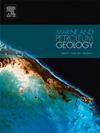Geological controls on shale gas accumulation in a synclinal reservoir and implications for natural gas migration
IF 3.7
2区 地球科学
Q1 GEOSCIENCES, MULTIDISCIPLINARY
引用次数: 0
Abstract
Shale gas exploration in the marine systems of southern China has predominantly targeted anticlines, while synclines have been regarded as high-risk areas due to potential gas loss along shale layers governed by structural morphology. Recently, commercial shale gas production has been identified in the Upper Ordovician Wufeng and Lower Silurian Longmaxi shales within the Baima Syncline, Southeast Sichuan Basin, sparking significant interest in exploring the geological controls on shale gas accumulation and migration in synclinal settings. Here, we characterize the shale microstructure, free and adsorbed gas capacities, and the chemical and isotopic composition of shale gas in relation to the tectonic evolution of the syncline, based on a sample set from five wells in the structurally isolated Baima Syncline. Total gas contents decrease from the center of the syncline (5.2 m3/t) through the limb (4.9 and 4.8 m3/t) towards the margin (3.8 and 2.4 m3/t), primarily due to a reduction in free gas content. Seismic profiles and microstructural analysis of organic matter (OM)-hosted pores reveal increasing structural deformation from the syncline core to its margins. This strong deformation reduces the free gas content through two mechanisms: (1) porosity loss due to compression of OM-hosted pores caused by structural deformation, and (2) lower pressure coefficients and reduced gas saturation at the syncline margins, where bedding-parallel microfractures formed by strong tectonic stress and enhance permeability and facilitate gas escape. Variations in δ13C1 values and the wetness of shale gas indicate minimal gas migration along shale layers within the syncline, typically less than 2 km, even over a geological timespan of approximately 90 million years. These findings suggest that the core and limb areas of synclines with weak structural deformation and adequate distance from faults could serve as promising targets for shale gas exploration, even in tectonically complex regions. Moreover, the limited gas flow along shale layers provides valuable insights into the CO2 storage potential of shale reservoirs.
求助全文
约1分钟内获得全文
求助全文
来源期刊

Marine and Petroleum Geology
地学-地球科学综合
CiteScore
8.80
自引率
14.30%
发文量
475
审稿时长
63 days
期刊介绍:
Marine and Petroleum Geology is the pre-eminent international forum for the exchange of multidisciplinary concepts, interpretations and techniques for all concerned with marine and petroleum geology in industry, government and academia. Rapid bimonthly publication allows early communications of papers or short communications to the geoscience community.
Marine and Petroleum Geology is essential reading for geologists, geophysicists and explorationists in industry, government and academia working in the following areas: marine geology; basin analysis and evaluation; organic geochemistry; reserve/resource estimation; seismic stratigraphy; thermal models of basic evolution; sedimentary geology; continental margins; geophysical interpretation; structural geology/tectonics; formation evaluation techniques; well logging.
 求助内容:
求助内容: 应助结果提醒方式:
应助结果提醒方式:


